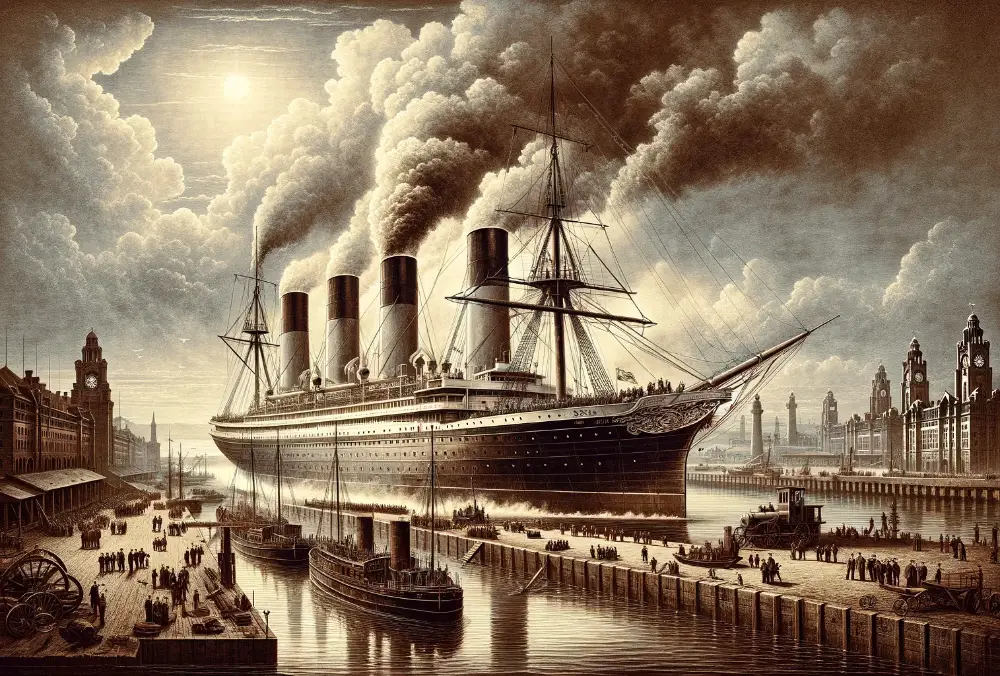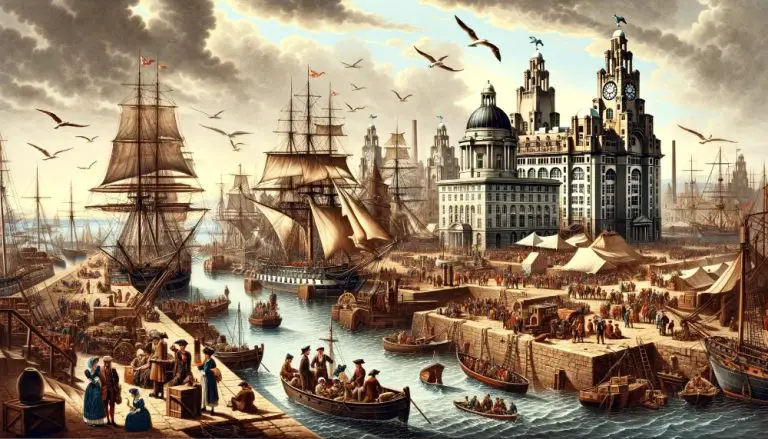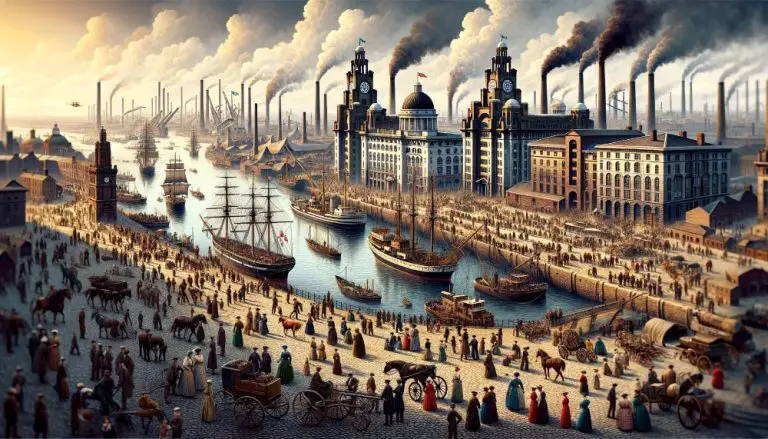The First Steam-Powered Vessel to Cross the Atlantic

The SS Great Western holds the distinction of being the first steam-powered ship to cross the Atlantic Ocean. This historic voyage took place in the early 19th century and marked a significant milestone in maritime history. The SS Great Western’s journey from Liverpool to New York put Liverpool at the forefront during the Industrial Revolution.
Key Takeaways
- The SS Great Western was the first ship to cross the Atlantic using steam power. This marked a major milestone in maritime history.
- The historic voyage took place in the early 19th century and showcased the potential of steam-powered vessels for long-distance travel.
- Liverpool played a crucial role during the Industrial Revolution as a major maritime hub and the starting point for the SS Great Western’s journey.
- The transatlantic crossing facilitated faster trade and communication between Europe and the Americas, opening up new opportunities for international commerce.
- The SS Great Western’s successful journey revolutionized the travel industry and paved the way for advancements in steamship technology.
The SS Great Western: A Game-Changing Vessel
The SS Great Western, built in 1837, was a game-changing vessel that revolutionized maritime travel. It was the first steam-powered ship to make a successful transatlantic crossing. The ship’s steam engine allowed for reliable and efficient propulsion, reducing dependence on wind and sail power. This marked a new era in transatlantic travel and paved the way for future advancements in steamship technology.
| Key Innovations | Impact |
|---|---|
| The SS Great Western was equipped with a powerful steam engine, allowing it to travel reliably and efficiently across the Atlantic. | This breakthrough in propulsion technology reduced travel time, making transatlantic journeys faster and more reliable. It opened up new opportunities for trade and travel between Europe and the Americas. |
| The ship’s design included spacious and comfortable accommodations, setting a new standard for passenger comfort on sea voyages. | This improved passenger experience attracted more travelers to maritime travel, increasing the popularity and accessibility of transatlantic crossings. |
| The SS Great Western’s success demonstrated the viability of steam power for long-distance voyages, inspiring further innovation in shipbuilding and steam technology. | It laid the foundation for the development of larger and more advanced steamships, which ultimately transformed global maritime travel and trade. |
By successfully crossing the Atlantic, the SS Great Western proved that steam-powered vessels were not only feasible but also superior to traditional sail-powered ships. This game-changing vessel set the stage for the future of maritime travel, shaping the course of history in the process.
Liverpool’s Role in the Industrial Revolution
The SS Great Western’s departure from Liverpool showcased the city’s importance during the Industrial Revolution. Liverpool was a major maritime hub and played a crucial role in facilitating international trade and commerce. The advancements in shipbuilding and steam technology made Liverpool a center of innovation and contributed to the city’s economic growth during this period.
| Industrial Advancements in Liverpool | Economic Impact |
|---|---|
| Liverpool was at the forefront of shipbuilding during the Industrial Revolution, incorporating new techniques and materials to construct larger and more efficient vessels. | The thriving maritime industry in Liverpool brought prosperity to the city, attracting merchants, investors, and businesses from around the world. |
| Steam-powered ships like the SS Great Western revolutionized transportation and trade, opening up new opportunities for global commerce. | The increased maritime activity in Liverpool stimulated economic growth, creating jobs and generating wealth for the city and its residents. |
| The port of Liverpool became a bustling center for importing and exporting goods, playing a vital role in the expansion of international trade. | Liverpool’s strategic location and robust maritime infrastructure made it an ideal hub for connecting continents and facilitating worldwide commerce. |
The industrial advancements in shipbuilding and steam technology solidified Liverpool’s position as a powerhouse of the Industrial Revolution. The city’s role as a maritime hub fueled trade and commerce on a global scale, contributing to the economic prosperity of not only Liverpool but also the entire British Empire.
The Significance of the Transatlantic Crossing
The first steam-powered vessel to cross the Atlantic had immense significance for global connectivity. This milestone in maritime history facilitated faster and more reliable trade and communication between Europe and the Americas. It opened up new opportunities for international commerce and strengthened ties between continents.
“The transatlantic crossing marked the beginning of a new era in maritime travel and set the stage for future advancements in steamship technology.” – Maritime historian.
With the successful transatlantic crossing, the SS Great Western demonstrated the feasibility of steam-powered travel on long-distance voyages. Prior to this, relying on wind-powered sailing ships posed significant challenges and uncertainties for trade and communication across the Atlantic.
The advent of steam power brought about a transformative change, enabling ships to travel with greater speed, efficiency, and reliability. This led to a more interconnected world, as trade routes expanded and communication between continents improved.
The significance of the transatlantic crossing was not limited to the realm of trade and commerce. It also had far-reaching cultural and social implications. The increased global connectivity facilitated by steam-powered vessels fostered the exchange of ideas, knowledge, and cultural influences between Europe and the Americas.
The Role of Transatlantic Trade and Communication
The transatlantic crossing played a vital role in fostering trade and communication between Europe and the Americas. It enabled the efficient transportation of goods, such as textiles, machinery, and raw materials, contributing to the growth of industries on both sides of the Atlantic.
Moreover, the improved communication facilitated by steamships allowed for faster and more reliable exchange of information and ideas. This led to greater cultural exchange, scientific collaboration, and the dissemination of knowledge.
“The transatlantic crossing marked the dawn of a new era, where global connectivity became a reality, laying the foundation for the interconnected world we have today.”
The transatlantic crossing also brought about a shift in power dynamics, as countries vying for global dominance recognized the strategic significance of this new form of transportation. The ability to navigate the vast expanse of the Atlantic Ocean with reliable steam power became a symbol of a nation’s technological prowess and economic strength.
In summary, the transatlantic crossing carried immense significance for global trade, communication, and connectivity. It marked a pivotal point in maritime history, ushering in a new era of steam-powered travel and fostering closer ties between continents. The impact of this milestone continues to resonate today, as steamship technology paved the way for further advancements in global transportation and communication networks.
The Impact of the SS Great Western’s Journey
The SS Great Western’s successful transatlantic journey had a profound impact on the travel industry and sparked a wave of technological advancements. It demonstrated the viability of steam-powered travel, paving the way for the development of larger and more efficient steamships. This breakthrough in maritime technology revolutionized the travel industry and set the stage for the growth of steamship companies and the expansion of transatlantic travel.
The SS Great Western’s successful voyage showcased the potential of steam power for long-distance travel, challenging the traditional reliance on wind and sail power. With its powerful steam engine, the ship was able to provide reliable and efficient propulsion, significantly reducing travel time and increasing passenger comfort. This newfound speed and efficiency revolutionized the travel industry, enabling people to journey across the Atlantic Ocean in a fraction of the time it previously took.
The impact of the SS Great Western’s journey extended beyond the realm of travel. The technological advancements pioneered by the ship’s steam engine paved the way for further innovations in maritime transportation. Steam-powered ships became the new standard, as they offered greater speed, reliability, and control over traditional sailing vessels. This led to the growth of steamship companies and the expansion of transatlantic travel, connecting continents and facilitating global trade.
Recognizing the Achievements of the SS Great Western
The SS Great Western, the first steam-powered vessel to cross the Atlantic, achieved remarkable milestones that shaped maritime history and technological innovation. Its successful transatlantic crossing paved the way for future advancements in maritime technology and revolutionized the industry.
“The SS Great Western’s voyage showcased the potential of steam power for long-distance travel and laid the foundation for the development of modern steamships. Its achievements have left an indelible mark on maritime history and serve as a testament to the progress of technological innovation in the 19th century.”
During its historic journey, the SS Great Western demonstrated the capabilities of steam-powered propulsion, which offered a more reliable and efficient alternative to wind and sail power. This groundbreaking achievement inspired further exploration and advancements in steamship technology, ultimately transforming the maritime industry.
The legacy of the SS Great Western is firmly rooted in maritime history and its pivotal role in technological innovation. The ship’s achievements continue to inspire and shape the development of modern ships and maritime transportation.
| Achievements | Impact |
|---|---|
| Pioneered steam-powered transatlantic crossing | Revolutionized maritime travel |
| Catalyzed advancements in steamship technology | Established steam power as a viable propulsion method |
| Set the foundation for modern steamships | Enabled faster and more efficient long-distance travel |
| Inspired further exploration and technological innovations | Shaped the evolution of the maritime industry |
The achievements of the SS Great Western continue to be celebrated in maritime history, highlighting the vessel’s significant contributions to technological innovation and its enduring legacy as a symbol of progress. By recognizing the SS Great Western’s achievements, we honor the pioneers who transformed the way we travel and connect through the seas.
The Legacy of the First Steam-Powered Vessel
The legacy of the first steam-powered vessel to cross the Atlantic lives on in the maritime industry. The SS Great Western’s groundbreaking journey paved the way for the development of larger, faster, and more efficient steamships. It marked a turning point in maritime travel and set the stage for the interconnected global shipping networks that exist today. The impact of this historic voyage is still felt in the technological advancements and innovations in the maritime industry.
The Evolution of Steamships
The SS Great Western’s transatlantic crossing sparked a revolution in the maritime industry, propelling technological advancements that transformed the way goods and people were transported across the ocean. The success of the SS Great Western proved the viability of steam power, leading to the development of larger and more sophisticated steamships.
Steam-powered vessels such as the SS Great Britain, built by Isambard Kingdom Brunel in 1843, further enhanced maritime transportation by combining advanced steam engine technology with innovative shipbuilding designs. These advancements resulted in faster and more reliable voyages, reducing travel time and increasing the capacity for cargo and passengers.
| Legacy | Technological Advancements |
|---|---|
| 1. Increased global connectivity | 1. More efficient steam engine technology |
| 2. Expansion of international trade | 2. Enhanced shipbuilding techniques |
| 3. Strengthened ties between continents | 3. Improved navigation and safety systems |
Influence on the Maritime Industry
The legacy of the first steam-powered vessel extends beyond technological advancements. The SS Great Western’s historic journey inspired a new era in the maritime industry, encouraging further innovation and competition.
Steamship companies emerged, striving to improve upon the achievements of the SS Great Western. This led to the development of larger and more luxurious steamships, catering to the growing demand for transatlantic travel. The maritime industry flourished as steamships became the preferred mode of transportation, revolutionizing global trade and connecting nations like never before.
“The SS Great Western’s voyage across the Atlantic changed the course of maritime history forever. It served as a catalyst for technological progress and paved the way for the modern shipping industry we know today.” – Maritime expert.
The legacy of the first steam-powered vessel continues to shape the maritime industry, with technological advancements driving further innovation. Today, ships are equipped with state-of-the-art navigation systems, advanced propulsion technology, and eco-friendly designs, all of which can be traced back to the groundbreaking journey of the SS Great Western.
Conclusion
In conclusion, the SS Great Western, as the first steam-powered vessel to cross the Atlantic, holds a significant place in maritime history. This momentous transatlantic journey not only marked a new era in maritime travel but also showcased the immense potential of steam power for long-distance voyages.
The achievements of the SS Great Western laid the foundation for future advancements in maritime technology, shaping the course of the industry. This pioneering vessel’s successful crossing established Liverpool as a prominent player in the Industrial Revolution, positioning the city at the forefront of maritime innovation and trade.
The legacy of the SS Great Western continues to influence the maritime industry today, reminding us of the remarkable progress made in the field of transportation. This historic voyage serves as a testament to human ingenuity and the relentless pursuit of technological advancements in maritime history.
FAQ
What is the significance of the SS Great Western in maritime history?
The SS Great Western holds the distinction of being the first steam-powered vessel to cross the Atlantic, marking a significant milestone in maritime history.
How did the SS Great Western revolutionize maritime travel?
The SS Great Western was a game-changing vessel that introduced reliable and efficient steam-powered propulsion, reducing dependence on wind and sail power. This revolutionized transatlantic travel and paved the way for future advancements in steamship technology.
What role did Liverpool play during the Industrial Revolution?
Liverpool was a major maritime hub during the Industrial Revolution and played a crucial role in facilitating international trade and commerce. The advancements in shipbuilding and steam technology made Liverpool a center of innovation and contributed to the city’s economic growth.
How did the transatlantic crossing impact global connectivity?
The first steam-powered vessel to cross the Atlantic facilitated faster and more reliable trade and communication between Europe and the Americas. It opened up new opportunities for international commerce and strengthened ties between continents.
What impact did the SS Great Western’s journey have on the travel industry?
The SS Great Western’s successful transatlantic crossing sparked a wave of technological advancements, demonstrating the viability of steam-powered travel. This revolutionized the travel industry, leading to the development of larger and more efficient steamships and the expansion of transatlantic travel.
Why are the achievements of the SS Great Western important in maritime history?
The SS Great Western’s transatlantic crossing as the first steam-powered vessel laid the foundation for future advancements in maritime technology. Its successful journey showcased the potential of steam power and contributed to the development of modern steamships.
How does the legacy of the first steam-powered vessel impact the maritime industry?
The groundbreaking journey of the SS Great Western paved the way for the development of larger, faster, and more efficient steamships. It marked a turning point in maritime travel, leading to the interconnected global shipping networks that exist today.
What is the conclusion of the first steam-powered vessel’s significance in maritime history?
The first steam-powered vessel’s transatlantic crossing was a momentous event that changed the course of maritime travel. The achievements of the SS Great Western continue to influence the maritime industry and serve as a reminder of the progress made in transportation during the 19th century.
Source Links
- https://en.wikipedia.org/wiki/SS_Savannah
- https://mcguirelibrary1998.omeka.net/exhibits/show/new-london-and-the-first-steam/the-great-debate–which-ship-w
- https://www.britannica.com/topic/Savannah-American-steam-ship
- The History Behind Liverpool’s You’ll Never Walk Along - February 16, 2024
- The History of Everton FC - February 16, 2024
- The History of Liverpool FC - February 16, 2024





